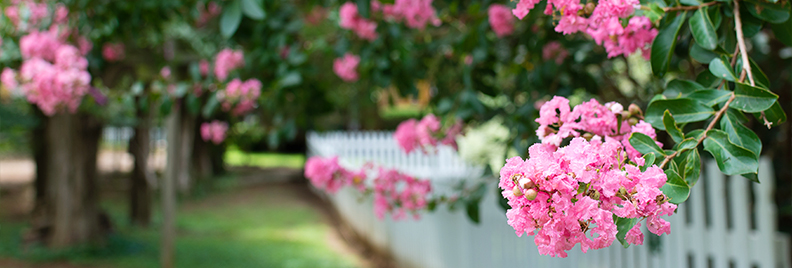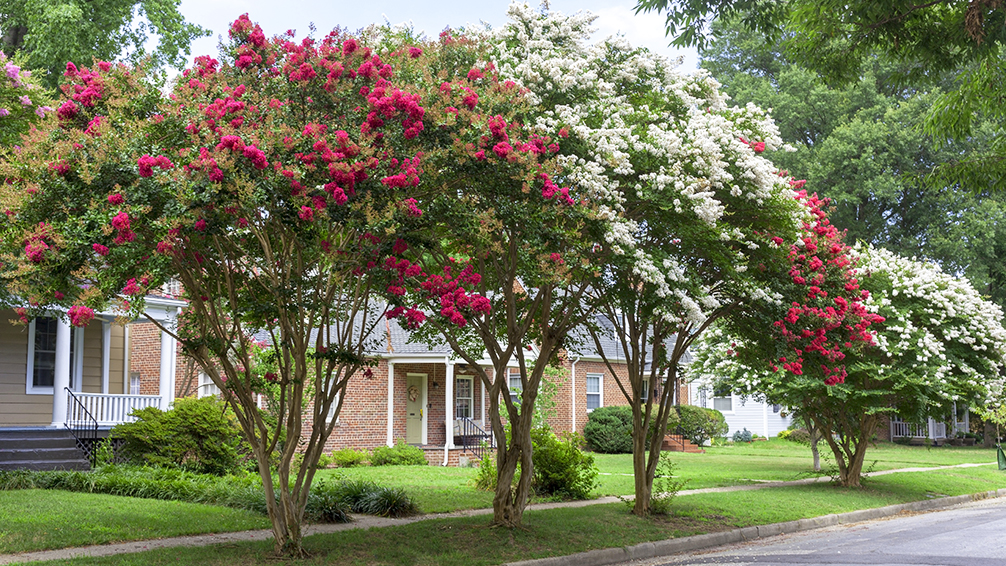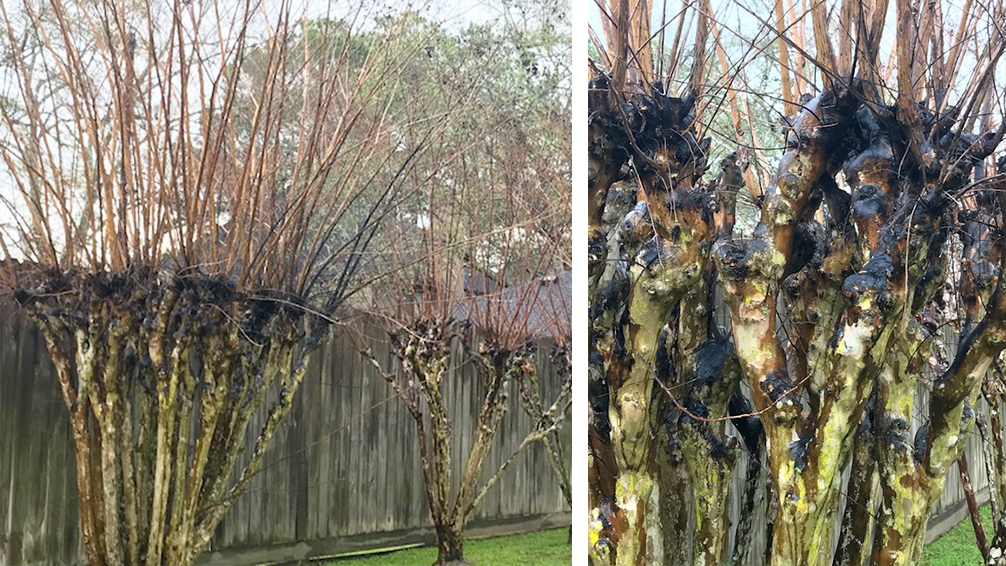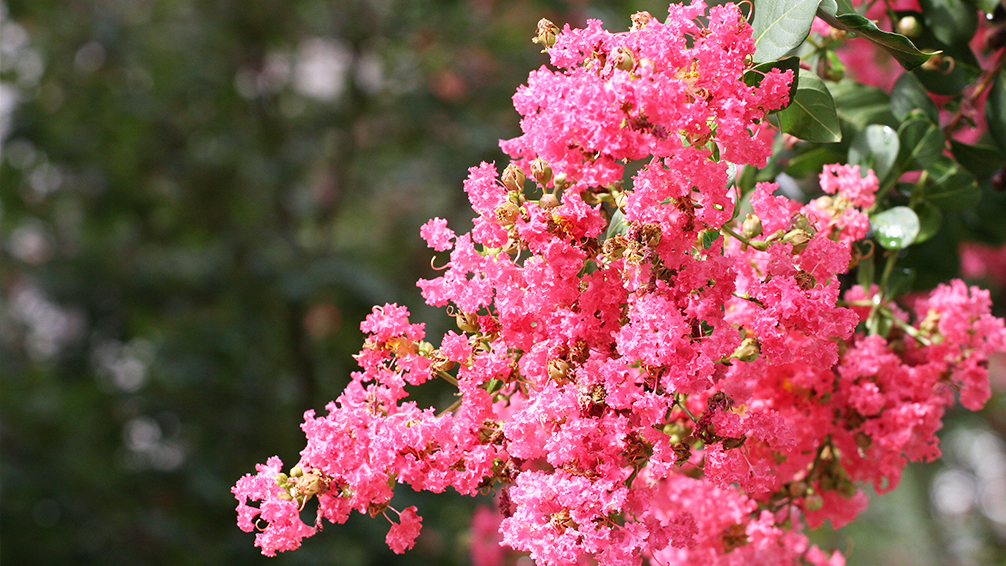
How To Prune Crape Myrtles (Without Totally Destroying Them)
Full disclosure: a lot of folks don’t know how to prune their crape myrtles correctly, and it’s leading to some pretty sad-looking trees. Plant lovers like us can’t help but recoil at the sight of this horticultural massacre. It’s time for an intervention!
Timing and technique are key when it comes to pruning these flowering machines. We’ve lined out all the basics, so you can trim it down to the perfect size without hacking it down to a stump. (Seriously, we’ve seen a lot of stumpy looking trees out there, and it’s a real travesty!)
Crape myrtles are a staple landscape tree here in the South, with their elegant, fabric-like blossoms, each more dramatic and voluminous than Ariana Grande’s dress at the Grammys. Here’s all the know-how you’ll need on how to prune crape myrtles in Houston, so your trees can steal the show and serve serious looks all year’ round.

Pruning Crape Myrtles At The Perfect Time
If you’re new to pruning shrubs and trees, it’s crucial to figure out which category your plants fall into; those that bloom on new wood, and those that bloom on old wood. Crape myrtles bloom on new wood, which means that they spring to life once temperatures warm up and develop blooms later in the summer as they grow longer branches.
Many of your other garden plants may bloom on old wood and need to be pruned in the fall to get tidied up before blooming in early spring. You’ll want to hold off on pruning your crape myrtles until a few months afterward because all those extra branches act as a protective layer during cool, windy nights.
At the beginning of spring, you can trim back the longer, ganglier branches and thin it to make room for new growth and maintain a more even shape. Leaving it alone will result in a pretty raggedy-looking tree, and it won’t grow as quickly either. The new growth will emerge on its own from the fresh cuts, and if you trim at just the right point, you’ll encourage way more blooms to appear.

Don’t Overdo It When You Prune Crape Myrtles
While crape myrtles are known for producing impressive amounts of new growth after a fresh spring trim, so many people go totally overboard and hack their trees down to stumps. This is arguably worse than leaving your tree untouched because you end up with weak, spindly regrowth, and you don’t get to enjoy the gorgeous mottled bark that develops over time. This is why you have to find that happy medium and trim it back just the right amount.
The only time you should cut your myrtle down dramatically is if you have a stem that looks completely out-of-place and is jutting out awkwardly. If there’s still a reasonable number of leaders left behind after you remove it, it will look more balanced and will continue to grow just fine. Cut the stem back as low to the ground as possible in this case.
If you want to maintain a tree shape with your crape myrtle and don’t want it looking too shrubby, trim back the branches developing lower down on the main stems. This technique will help leave some headroom underneath the main branches. Mature crape myrtle trees look best when the branching doesn’t start until 6 to 8 feet off the ground.
Where To Prune Your Crape Myrtles
For typical branch shortening and general tidying, it’s good to cut some off from the top and sides, while also thinning out the tree and removing some thinner branches at the base. Leaving a bit more space between branches will help increase air circulation to prevent bacteria like powdery mildew from forming, Plus, it also allows for more space for new growth, so things don’t get too cramped. Branches that cross over each other should be nicked off—that extra friction can lead to serious damage that anyone who has experienced thigh chafe can sympathize with.
When cutting back crape myrtle branches, look for a bud that’s pointing in the direction you’d like your branch to develop and make your cut just above it. Any unwanted suckers, or stems that are jutting inwards, should be nipped off at the base. No need to hack off the tops of the main trunks — just a little trim will help. Weak, thin branches that aren’t likely to hold up much new growth aren’t really worth keeping, so you may as well chop those guys outta there, too.

The Best Tools To Prune Crape Myrtle
The size of branches you’ll need to prune off will vary quite a lot with a multi-trunk tree like the crape myrtle. Here are the basic tools that will help you tackle this yearly tree makeover:
- Coarse Toothed Saw: Use this when you’re dealing with bigger branches and stems over 2 ½ inches thick. The larger teeth are way better for slicing through thick wood, but it’s a little bit trickier to avoid damaging the surrounding growth.
- Fine Toothed Saw: This saw is useful for slicing branches up to 2 ½ inches thick. Try to find one with a curved blade, as most people find these are the easiest ones to maneuver.
- Lopping Shears: You’ll typically find that lopping shears come on long handles and allow you an extra foot and a half of reach, which is super helpful when pruning tall trees. They can cut branches up to 1 ¾ inch thick. Also, you should probably wear some headgear if you’re gonna do some overhead pruning with these bad boys. (It’s hard to avoid getting in the way of falling branches when you’re cutting them above your head!)
- Pole Pruner: This nifty tool typically features a saw blade with a pruning shear blade up at the top. It has a much longer extended handle for those hard-to-reach spots, with some models extending up to 12 feet.
- Hand Pruner: This basic tool is perfect for nipping off small stems and branches. Remember to disinfect the blades well after cutting if you’re dealing with a plant that’s showing any signs of disease or pest infestation.
This spring, there’s no need to go full American Psycho on your crape myrtles. Resist the urge to chop their branches down drastically, and instead just thin it back and trim the tops where wood is weak and less developed. You’ll be left with a much happier shrub or tree with steady, healthy growth and an impressive display of flowers. And that’s the whole point of having one, right?

Come visit us at Plants For All Seasons in Houston if you need some new tools to prune your crape myrtles, or if you have any other questions about getting the job done. And remember: be kind to your crape myrtles! This is a seasonal pruning, not an emergency amputation.

Comments (3)
Thank you!!!!
I’m from East Texas and our crepe myrtle survived the blizzard. We trimmed the smaller dead limbs from the top. We have 3 large branches from the trunk and had growth from one. Now new growth is growing from the trunk bottom and the new growth from the top is dying. We don’t want to totally kill our tree. Do we need to cut off the growth from the bottom or cut off the larger branches from the trunk and let the new growth from the bottom continue?
I have a crepe myrtle that is about 75′ tall. It’s got 3 trunks and the limbs are about 30′ high. Just moved in to the house and wanting to know what I can do to bring it back down to reality without taking it out. Can I cut it down to the ground or maybe 3-4 feet from the ground
Comments are closed.